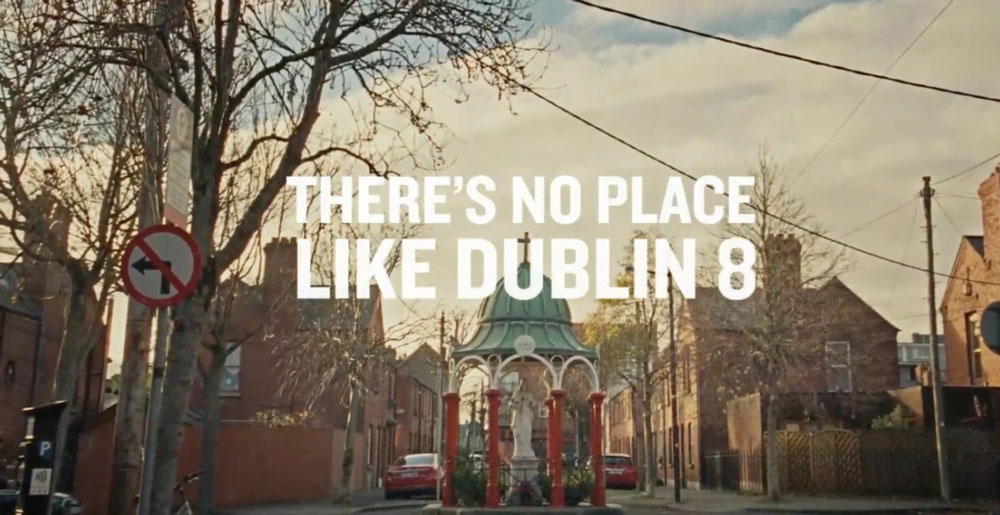 With so many of our traditional structures of connection in a state of flux, we have unwittingly created a loneliness crisis in Irish society. But as Viv Chambers, Sarah Van Horn and Emma McCarthy of Bricolage argue, there is a clear role for brands to play in fostering a society that is more resilient and feels like everyone is “in it together”.
With so many of our traditional structures of connection in a state of flux, we have unwittingly created a loneliness crisis in Irish society. But as Viv Chambers, Sarah Van Horn and Emma McCarthy of Bricolage argue, there is a clear role for brands to play in fostering a society that is more resilient and feels like everyone is “in it together”.
Loneliness is not just a site of private struggle – it’s a widespread societal challenge.
As the cultural commentator Olivia Laing writes her book ‘Lonely City’ (2016):
“Loneliness is by no means a wholly worthless experience, but rather one that cuts right to the heart of what we value and what we need”.
Brands that have a meaningful role in culture also cut to the heart of what we value and need. Addressing loneliness, therefore, isn’t just an opportunity for cultural relevance – it’s a chance for brands to create meaningful impact.
Ireland’s Loneliness Crisis
Over the course of the past six months at Bricolage, we’ve undertaken extensive research on the topic of loneliness, including a literature review, focus groups with people aged between 20 – 70 across Ireland and interviewing experts in psychology, community care and placemaking, and cultural strategists.
What we discovered was startling: Ireland ranks as the loneliest country in the EU, with over one third of adults describing themselves as lonely (European Quality of Life Survey 2022).
The latest WARC GEISTE report on macro trends shows that the issue of loneliness is a trending topic globally. But in Ireland, its roots run particularly deep. Understanding the particular dynamics here – and the role brands might play in mitigating them – can help us rethink our relationship with something we can struggle to accept, let alone address.
The Double-Edge of Loneliness
Loneliness, as psychologists suggest, is a neurological signal. Much like hunger is a signal for sustenance, loneliness is a signal for connection.
When we look at loneliness as a signal, what’s interesting is that it can be seen to have a positive side – functioning as a useful reminder that we need to connect with others. Loneliness is also, as one of the psychology experts we spoke to told us, a fundamental part of the human experience.
Saying that, it’s important we don’t fudge the facts – chronic loneliness is associated with significant emotional, mental and physical distress.
In various countries there is a significant medical and social response to a worrying increase in a phenomenon that is linked to similar morbidity outcomes as obesity and smoking. We are living in a time when – for good or for bad – loneliness is becoming increasingly seen as something we can treat, with cures like ‘social prescribing’ on the rise.
In the Netherlands, the response has reached the level of a ‘National Coalition Against Loneliness’. Members include banks, football clubs, well known charities and supermarkets and they work on various initiatives to tackle loneliness in local areas.
The challenge, then, is twofold: shifting the narrative around loneliness from shame to shared humanity while addressing its structural causes.
The Structure of Loneliness … and what that means for brands
Through our research, we identified five key drivers that are contributing to the current spike in loneliness:
A geography of loneliness
Physical spaces that once brought us together are disappearing.
The rise of working from home – despite its clear benefits – denies us the water cooler moments, incidental desk drop bys and the serendipitous commuter connections.
The decline of ‘third spaces’, those places in between work and the home – like churches, pubs, community halls – stifle potential for spontaneous encounters and productivity free conversation.
And the gradual migration (instigated by Covid) out of city centres to more rural and isolated locations can make unplanned encounters harder.
The death of these IRL spaces has the knock-on effect of making it hard to socialise in any kind of a spontaneous or unstructured way.
Loss of Shared Rituals
Catholicism once provided unifying stories and communal rituals that offered answers and guidance to life’s biggest questions. The 2022 CSO reported that since 2011 there has been a 187% increase in the number of people identifying as having ‘no religion’.
Whilst this is seen as progress by many, the people we spoke to in focus groups shared a sense of nostalgia for the communal bonds that these rituals fostered – bonds that have not been easily replaced.

Technology’s Broken promise
Technology is fundamentally changing our human relationships. By offering us an easy way to bypass IRL interaction, technology helps us to avoid the inherent messiness of relationships.
The psychologist Sherry Turkle says tech tidies up human interaction by removing the friction we need for true connection. (Deliveroo, for example, removes the friction of inconvenience but it sweeps up a host of everyday human interactions also).
Nowhere is this more apparent than on social media – where clicks, likes and shares offer an immediate and initially satisfying dopamine hit but fail to deliver when it comes to deep or meaningful connection.
Social Narrowing
The pandemic forced a premature prioritization of strong tie relationships (close friends and family), as we were forced to retreat from unmediated and unstructured social interactions.
This undermined our loose ties with casual acquaintances, which are essential for a sense of belonging. In conjunction with this, the hyper personalisation of online algorithms has facilitated the growth of niche, taste communities and online fandoms. These cohorts have their benefits in the bringing together of people, but they also give rise to the echo chamber effect, allowing people to stay within a bubble of like-minded individuals.
It is notable too that the integrating into Ireland from a foreign national perspective can be mixed at times as traditional structures such as the GAA may not be a good cultural fit for belonging and a socially narrow friendship structure can prevail.
As one of our community activists mentioned “The GAA can’t save everyone”.
Intense Individualism
More than any other time in the history of Ireland, there is an increased focus and importance placed on speed, productivity and autonomy – on personal self-realization vs. communal well-being. (We are number 1 for productivity in the OECD after all).
In this context, time is seen as a finite resource, one that must be used carefully with a clear output or tangible goal in mind. As we spend more time looking inward for solutions, productivity burnout is treated more often by individual self-care, than coming together in communal places. This leaves many to struggle alone.
Where Brands Can Make a Difference:
Normalize the Conversation: There remains a widespread sense of individual shame in admitting to feeling lonely. It is linked to a sense of personal failure in our culture.
Brands can challenge this by normalizing the conversation. An example of this is NYC’s ‘Belong Centre’, who take a ‘joyful’ and preventative approach to loneliness.
Key initiatives include their ‘Belong’ benches across the city which encourage strangers to sit down and have a conversation, as well as Belong block parties and in person Belong circles to provide people with easy ways to start a conversation.
Champion Collective Wellness: We know from the focus groups we held that ideas of interdependent communities are now highly aspirational. People are increasingly ‘community curious’.
Campaigns like the Guinness ‘There’s no place like Dublin 8’ campaign celebrates a community of people in the Liberties who rely heavily on each other outside of just tight familial relationships. Family run businesses are supported ahead of chain stores and community connections are seen as an essential part of daily life.

Create “Places to Be”: As brands look to establish brick and mortar hubs for their communities, it is important they remain third spaces and not just brand spaces. Third spaces are public and inclusive, offering people a way to come together and commune without the specific goal of consumption.
Adidas’ sponsorship of Stormzy’s ‘next level’ community centre for young people in Croydon is an example of a brand facilitating community, without over-intruding and diminishing its authenticity.
Design for Interaction: For spontaneous, non-tech-related interactions to occur, time and space must come together to gently nudge people into casual connection and conversation.
These can be achieved by rethinking everyday design elements, of which Jumbo’s Supermarket in the Netherlands have been massively successful. Jumbo’s Slow Lane checkouts allow customers extra time to chat both with people in the queue and with the cashier.
Support New Communities: While online spaces can often be blamed for increasing loneliness, there are in fact many communities that use online and hybrid ways to foster connection and belonging.
Outside more transactional networks which can enable information sharing and learning, relationship-based communities enable people to have meaningful interactions about real life experiences.
A good example of a relationship community that builds deep personal connections is the app ‘Inner Cycle’ which has a chat called ‘Heavy Cycles’. People come together to discuss life’s heavier moments and have a weekly zoom breakfast.
Interest based communities bring people with similar passions together online. Geneva is an online platform that through a group chat connects people with others who have similar interests – like running, dinner and drinks or thrifting – and enables them to hang out IRL.
At Bricolage we are big fans of Rapha the cycling apparel brand who blend online and in real life spaces to bring local cyclists together
A Collective Call to Action: Loneliness is not just an individual struggle. It is a signal of wider societal change and challenges that feels uniquely accelerated in Ireland. So many of our traditional structures of connection are in flux.
By fostering connection, reclaiming third spaces and changing the narrative around loneliness, many brands are well positioned to take a credible role in the solution.
As the Dutch and others have demonstrated, this is more than a marketing opportunity. It’s a chance to build a society that feels more ‘in it together’ and therefore resilient to the buffetings of global change. The question is, will your brand step up?
For a copy of the full report reach out to us at culturelab@bricolage.ie






















